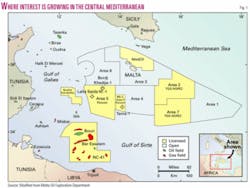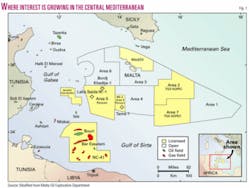Recent events point toward acceleration of exploration off several countries in the central and eastern Mediterranean Sea.
Anadarko Petroleum Corp., Houston, took a farmout from Pancontinental Oil & Gas NL (Pancon), Perth, to explore Pancon’s offshore Malta exploration study area.
MedOil PLC, London, was awarded an exploration study area north of Malta. Medoil and TGS-NOPEC Geophysical Co., Oslo, plan to acquire 3D seismic data later this year over a previous oil discovery on a block off Tunisia near Malta and Libyan waters.
ENI SPA, Milan, and partners are near start-up of Bahr Essalam oil and gas-condensate field off Tripoli as part of a megaproject in which Wafa oil and gas-condensate field in the Ghadames basin onshore Libya started producing in September 2004 (OGJ, Nov. 8, 2004, p. 39).
In the eastern Mediterranean, InSeis AS, Lysaker, Norway, began acquisition of about 5,000 km of multiclient 2D seismic data on the shelf off Syria. Results are to be available in September. The survey is to cover Syria’s entire offshore area.
Exploration off Malta
Anadarko can earn as much as 65% interest in two areas held by PanCon by running a 2D seismic survey and then entering into a production-sharing contract by the end of June 2006.
The contract will lead to the drilling of an exploration well before Dec. 30, 2007.
An additional 10% interest can be earned by drilling a second well at Anadarko’s cost.
Pancon, with 32% interest, and its two coventure partners, Afrex Ltd. 48% (soon to merge with Pancon) and Sun Resources NL 20%, both of Perth, will be carried through the Anadarko earning period. Their respective interests will drop to 11.2%, 7%, and 16.8% after drilling the first well.
The 14,800-sq-km study area lies on the Pelagian platform, southwest of Malta and adjacent to Libyan and Tunisian waters in the Mediterranean. Known as Area 5 and Block 3 of Area 4, it includes two large prospects-Chianti and Limoncello-delineated by the Pancon group in 2004.
The acreage, in 100-400 m of water, is expected to have potential for limestone reef plays. PanCon recorded 260 km of 2D seismic data in August 2004 in as much as 250 m of water.
The area’s prospectivity is enhanced because producing oil and gas fields like Miskar and Isis off Tunisia and giant Bouri off Libya are deemed to be analogous to the Malta structures (see map, OGJ, July 5, 1993, p. 60).
Blocks off Malta, Tunisia
MedOil signed a 1-year exploration study agreement in May 2005 covering Areas 2 and 3 of Block 3 north of Malta.
The northern boundary of the 4,000-sq-km permit defines the Malta-Italy border.
At least three large, potentially oil-bearing structures are identified. The plan is to evaluate those structures and explore for others, said David M. Thomas, an executive director of MedOil.
The main source rock is expected to be the organic-rich Streppenosa shale, which sourced several fields in Sicily. Giant Vega oil field with 1 billion bbl of original oil in place is 20 km from the block’s northern boundary. MedOil’s interest is 100%.
In Tunisian waters north of Isis oil and gas field, MedOil at the end of May 2005 signed an agreement to explore the 4,100-sq-km Louza Permit.
Louza, in 30-200 m of water, has an existing oil discovery that flowed 1,200 b/d of 34° gravity oil from one reservoir and 118 b/d of 16° gravity oil from a deeper horizon. Near the discovery are four undrilled prospects.
MedOil with 95% interest and TGS-NOPEC with 5% plan to run a 600-sq-km 3D seismic survey in the third quarter of 2005 over the oil discovery and four prospects.
Lundin Petroleum AB, Stockholm, produces about 1,000 b/d from Cenomanian Isis limestone in Isis field into an FPSO that it plans to move to Oudna field off northern Tunisia after Isis is depleted (OGJ Online, July 3, 2003).
Libya’s first gas platform
Gas-condensate and oil production were to start soon at Sabratha, Libya’s first offshore gas platform, in Block NC-41 about 110 km northwest of Tripoli.
The platform serves Bar Essalam field. A group led by ENI, with 50% interest, is to start gas-condensate and oil production in mid-2005 through pipelines to shore processing facilities at Mellitah, west of Tripoli. There, gas not reserved for use in Libya is exported to Italy via the 860 MMcfd Greenstream pipeline in as much as 1,127 m of water to Gela, Sicily.
After Bar Essalam joins Wafa field, which began producing in the fall of 2004, combined production is slated to peak at 240,000 boed in 2006. Wafa is on Block NC-169.
Meanwhile, Joint Oil, an entity owned by state Entreprise Tunisienne d’Activites Petrolieres (ETAP) of Tunisia and National Oil Corp. of Libya, has been trying to attract a qualified operator to explore and develop the 7th of November block on the shelf between Bouri and Isis fields.
The block covers 741,000 acres in 80-120 m of water and has several play possibilities as defined by the surrounding fields and discoveries.
Elsewhere, operations are slowly starting on Gulf of Sirte nearshore blocks 18, 35, 36, 52, 53, and 54 that Libya licensed early this year (see map, OGJ, Apr. 18, 2005, p. 29). Petroleo Brasileiro SA, Woodside Petroleum (Pty.) Ltd., and Amerada Hess Corp. operate the blocks (OGJ Online, Feb. 15, 2005). ✦

